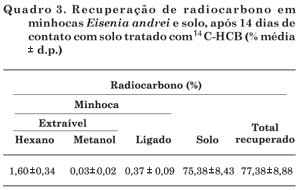HCB (hexachlorobenzene) is an environmentally ubiquitous organochlorine compound and is classified as one of the persistent organic pollutants (POP). It is highly toxic and has been found in the region "Baixada Santista" of the state of São Paulo (Brazil) for a number of years. To evaluate the potential of the earthworm species Eisenia andrei as bioindicator of HCB-contamination, earthworm specimens were maintained for 14 days in soil containing 14C-HCB, and their bioaccumulation was analyzed. No mortality was detected after neither 7 nor 14 days of contact with the treated soil, indicating that the dose was sub-lethal and would enable a biondication study. Soil and animal tissue samples were submitted to solvent extraction 14 days after the beginning of the study to determine radiocarbon, HCB and lipid contents in the organisms. Most of the radiocarbon from the applied 14C-HCB remained in the soil in the form of extractable residue and only small amounts were found in the animal tissues as extractable and bound residues. The gas chromatography of the extracts detected only HCB and consequently, no degradation occurred, neither in the soil, nor in animal tissues. The lipid content of the earthworm tissues was negatively correlated with HCB amounts (-0.2), indicating that HCB may have inhibited lipid formation. Finally, the bioaccumulation factor (BAF) of 6.5 indicated that HCB is actually bioaccumulated by the worms which indicates that this animal may be used as bioindicator in HCB-contamination studies.
earthworms; organochlorine compound; persistent organic pollutant; bioaccumulation factor




